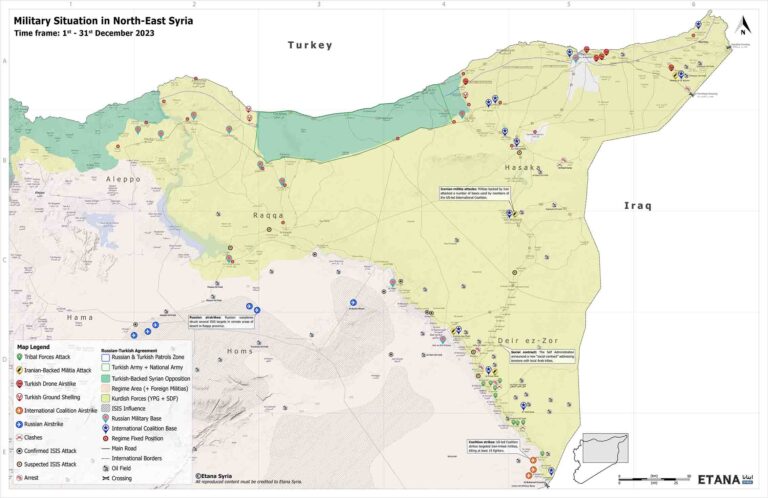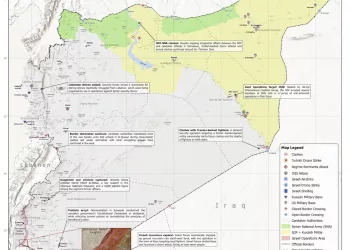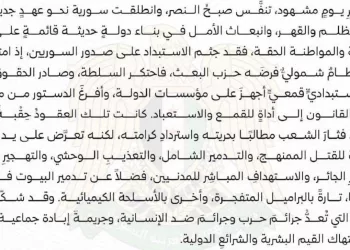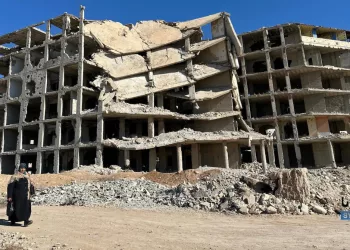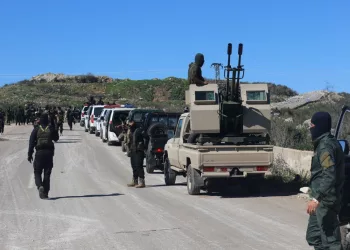Iranian-backed militias resumed a wave of attacks against bases used by the US-led International Coalition, following the breakdown of the temporary ceasefire in Gaza that had also brought a period of calm to north-east Syria. Militants launched dozens of surface-to-surface missiles and several suicide drone strikes against coalition bases and infrastructure in Hasakeh as well as the al-Omar and Conoco fields in Deir Ezzor—however, most projectiles landed in the vicinity of intended targets without inflicting casualties. Several of these attacks originated from Iraqi territory. In response, International Coalition aircraft launched several retaliatory strikes against militia positions—including Lebanese Hezbollah and Islamic Revolutionary Guard Corps (IRGC) sites—resulting in the deaths of at least 15 Iranian-backed fighters. Elsewhere, with the Syrian Democratic Forces (SDF) still battling a sporadic conflict with dissident tribal forces in Deir Ezzor, the Self Administration has launched some reform measures meant to offer a new “social contract” with communities in the region and address issues of Arab tribal representation in local governance bodies.
Attached Map:
Military Situation in North-East Syria
(For a high-resolution version of this map, please use the form at the bottom of the page)
Iranian Activity
Iranian-backed militias have continued to regularly target bases used by the US-led International Coalition in recent weeks, launching dozens of surface-to-surface missiles and suicide drone attacks against sites in Hasakeh and Deir Ezzor provinces. Many of these attacks originated from Iraqi territory. Targeted locations included sites in Hasakeh as well as the al-Omar and Conoco fields in Deir Ezzor.
In response to repeated attacks by Iranian-backed militias, the International Coalition conducted a series of retaliatory airstrikes in late December targeting militia positions in al-Bukamal. At least 15 militia members were killed in the strikes.
SDF Activity
Sporadic clashes with tribal forces continued throughout the first half of the month, although the long-running conflict that has destabilized Deir Ezzor province since the summer slowed markedly in recent weeks. Arab tribal forces targeted SDF military points and patrols, ultimately killing three SDF soldiers and injuring at least six others.
The SDF has continued to sustain attacks from Turkish forces and the Syrian National Army (SNA), with bombardments intensifying on a nearly daily basis during the second half of December. In recent weeks, drone and artillery strikes targeted SDF positions in Hasakeh and Raqqa provinces.
ISIS Activity
The number of ISIS attacks against the SDF continued trending upwards in recent months, with December witnessing a total of 12 armed attacks and two IED blasts. Altogether, 15 SDF soldiers were killed and at least 11 others wounded. Syrian regime forces lost nine soldiers to ISIS attacks in the month of December—all of them killed in one armed ambush and a single IED explosion.
Russian & Regime Activity
Russian forces have resumed a years-long aerial campaign against ISIS in the central Badia desert, striking targets in western Raqqa and in southern Raqqa. Russia’s campaign of bombardment has been largely ineffectual in curbing ISIS attacks and activities in the region.
Political & Humanitarian Developments
After months of consultations and negotiations, the Self Administration has unveiled several reforms meant to represent a new “social contract” with communities in the north-east, and specifically to address issues of Arab tribal representation within local governance structures. The reforms also include an official name change of the Self Administration’s political entity from the Kurdish “Rojava” to the more inclusive “Democratic Self Administration in North and East Syria.”


